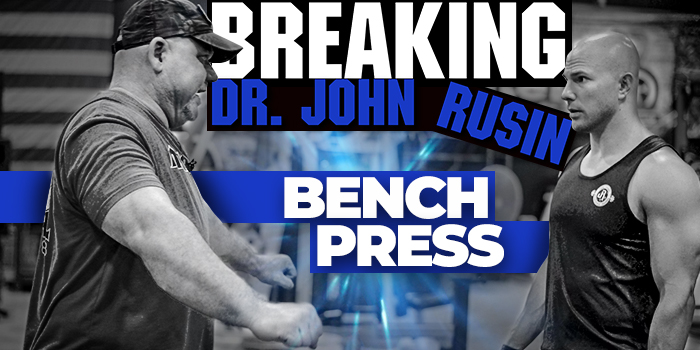
As part of the Fixing Dave Tate Series that kicked off earlier this year, Dave Tate worked closely with Dr. John Rusin to conduct a physical evaluation and develop a training program to reduce his daily pain. Having progressed through this journey over the past several months, Tate has since recognized the benefits and insights that he gained in the process. Yet, he is not alone – Dr. Rusin also acknowledges the headway that was made during the series.
In fact, while conducting the Fixing Dave Tate project, Rusin began to consider how this kind of process could be applied to his own training. Although he is no longer a competitive athlete, he still wants to be a role model for his clients by growing stronger and building the “big three” lifts: squat, bench press, and deadlift. As Rusin emphasizes with his own clients, health should always be the number one priority, but performance is a close second – and he sees the big three lifts as key indicators of overall performance.
RECENT: Breaking John Rusin — The Squat
As astutely stated by Rusin, “Every great coach needs a coach – they need somebody else to look in from a different, niche part of the industry”. Not only is this true, but when it comes to optimizing movement patterns to build the big three lifts, there is perhaps no coach more qualified than Dave Tate. In working together, they have the ability to flip the script and develop a 6-12-month program to accelerate Rusin’s progress on these main accessory lifts.
In alignment with this plan, Rusin recently joined Tate for an individual coaching session to break down his bench press technique. As Tate observed Rusin, he provided targeted cues and hands-on instruction to correct the bad, elevate the good, and enhance overall performance. From muscle isolation, to max effort work, to spotting technique, and sticking points, Tate customizes his coaching specifically for Rusin, thereby taking his bench press to the next level.
Tate explains that when doing these types of coaching sessions, the athlete must warm up in their usual routine – that’s why Tate avoids coaching warm-ups. If an athlete is used to warming up with improper technique, then they have to warm up with improper technique before working with Tate. This allows Tate to establish a baseline for change and prepares the athlete’s body to alter certain patterns without a complete shock to their system.
Rusin starts out on a Reverse Band Press for maximum effort work. In warming up, he notices that the bar does not actually touch his chest as he lowers it down. Tate, however, states that this is exactly what he wants for the first warm-up sets on a Reverse Band Press. Not only is Rusin not familiar with this type of bar, but he actually has to stop and pull the bar down the last bit of space to his chest. This allows him to become comfortable and get his muscles warm before Tate begins the breaking process.
Isolating the Lats
As they begin to work on technique, Tate immediately notices that Rusin is struggling slightly to stabilize his bench press. One likely cause that he identifies is that Rusin’s lateral muscles are not fully engaged during the movement. Although many people claim that lats don’t do much to support a bench press, Tate disagrees:
If you pull your hands back into a bench press position and flare your laterals, your hands came forward…I’m not saying you [should] do a lateral spread at the bottom of the bench; All I’m saying is that your lats do stabilize, and it does become something your triceps are going to drive off of.
As such, Tate works with Rusin to tweak his form to try and increase tension in the upper back and thoracic. To demonstrate the amount of tension that should be driving into the bench press pad, Tate instructs Rusin to do a series of glute bridges with his feet placed on the bench. He encourages Rusin to maintain that sense of tension in his traps, thereby keeping his shoulder blades locked and tight during the press. Tate provides the expert tip that if Rusin actually pulls the bar over the J-Cup (as opposed to pushing up and over), then he will flex his lats harder, thereby creating greater stabilization at the top.
Transfer of Force
Next, Tate provides guidance that will assist Rusin with the transfer of force. He says that, unlike the typical bodybuilder, powerlifters with proper form tend to let the weight “settle into them”, which ultimately enables them to be tighter and more stabilized. Bodybuilders train in an up-down fashion, which means that they can produce force, but they are unable to effectively stabilize or absorb force. He coaches Rusin to pull his shoulder blades together and down, use his legs to drive down into the bench to tighten the body, squeeze the bar, let the weight settle, and then go into the bench press movement.
Tate pinpoints another issue that is preventing optimal transfer of force – Rusin’s feet are not evenly placed on the floor. From this uneven position, he is unable to effectively push down and back into the bench because one foot is driving more force than the other. Although this may seem like a minor issue now, it could become much more of a problem with maximal weight.
Triceps and Elbows
As their discussion moves to arms, Rusin admits that over time, he’s come to rely heavily on his triceps in the bench press given past tears in his ligaments. Having torn both his pecs, Tate nods in understanding, but advises Rusin to try a thumb-less grip on the bar, as long as it’s safe and tight. Additionally, the range of motion at Rusin’s elbows is huge, which means that he shouldn’t necessarily be locking his arms out during the press. In fact, as Tate acknowledges, it appears that Rusin is almost double-jointed. As such, for his particular build and frame, he should avoid locking his arms out because it creates a significant amount of stress on the joint.
The placement of the elbows is critical in the bench press. Tate explains that he typically does not like to see a lifter’s elbows go lower than the top of the bench pad. The goal is to raise the sternum higher, keeping the back tight and the shoulder blades together. To reinforce this behavior, Tate has Rusin reverse-grip the bar and lift his upper-body up off of the bench – almost like a chin-up. This helps to pack the shoulders and get a little bit more arch.
As Rusin begins to tire during the training, Tate explains that max effort work should feel this way – it’s difficult, exhausting, and often uncomfortable. His point is that all athletes fall on a continuum between explosiveness and strength, and as they do more maximum effort movements, they will discover those exercises that tests their weaker areas.
Art of Spotting
Tate takes a moment to share his technique on a rarely-discussed (but crucial) aspect of powerlifting: spotting. He demonstrates that as Rusin sets up and prepares to take the bar, he’s pushing the bar against the J-Hook and holding it to prevent it from rolling around. This allows the lifter to more seamlessly pull the bar out over the J-Hook to begin the press. As the lifter takes the bar, the spotter should still be doing a good amount of the work (roughly 60% accordingly to Tate), and the hand-off between the two should be smooth and slow.
WATCH: Equipment Feature — elitefts Custom Bench
As the lifter brings the bar down, the spotter should make a point to stay away from their hands and avoid obstructing their view. If the lifter is at risk of dropping the bar or just needs additional support, the spotter should have their hand lightly on the bar the whole time. This is not to help them lift the weight, but rather for safety purposes to avoid injury. Tate also mentions that a mixed grip in terms of hand placement on the bar can provide more control as to where the bar lands in the case that it is dropped.
Static Strength
After watching Rusin struggle to hold the load at the top of the press, Tate returns to their lats stability discussion. He sees this as Rusin’s major weak point in the bench press: it’s all about isometric, or static, strength. To help address this, Tate recommends two exercises. The first is that at the end of every max effort exercise that Rusin does, he should make a point to hold the load at the top for a couple of extra seconds. The second exercise as part of his training should be to hold something that’s unstable, whether it’s a Bamboo Bar with plates, a Tsunami Bar, or even PVC pipe – just something that wants to move. If Rusin starts to shake too much or becomes fatigued while holding the bar, he can then bring it down to hold near his chest. A few reps with the Tsunami Bar are good as well, as long as the lifter is stable enough. Nevertheless, the majority of the work on this exercise should be at the top to isolate and strengthen the lats.
Sticking Points
Not only does max effort work enable powerlifters to diagnose technical issues, it also helps to shed light on weak points. Whether you refer to this as a mini-max, sticking point, or weak point doesn’t matter. The important thing to note for Rusin is that his particular sticking point is at the top, and he is not going to be able to address it by just benching more. In fact, as Tate acknowledges, benching is likely the reason that he even has this sticking point to begin with. If Rusin were to simply keep benching, he would only reinforce the sticking point and create more fatigue without actually addressing the problem.
In Rusin’s case, he should try to address this issue by doing speed work. Tate describes an exercise in which a lifter aims to break a karate board by accelerating to strike the board with an increasing amount of force, building up to finally breaking the board. Once Rusin can work up to that point, then he would simply need to increase lockout strength – a relatively easy feat in powerlifting with the help of special exercises and shoulder development. Yet, lockout strength is not Rusin’s root issue. Rather, it’s the stability work – it’s building up to finally bust through that karate board. By addressing this specific sticking point, Rusin has the potential to see major improvements in his bench press performance.










1 Comment